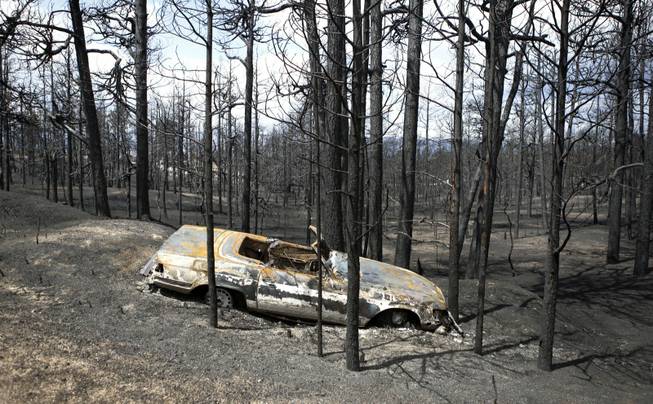
Ed Andrieski / AP
A burned automobile sits off the roadside in the burned forest on the Black Forest wildfire north of Colorado Springs, Colo., on Monday, June 17, 2013. Over 470 homes burned in the wildfire that started last Tuesday.
Tuesday, Oct. 6, 2015 | 5:40 p.m.
CASPER, Wyo. — New research by scientists at the University of Wyoming has found that extreme wildfire seasons are nothing new in the Rocky Mountain region: They also happened hundreds of years ago, after global temperatures had risen slightly.
The study suggests that fire seasons like the last bad one, in 2012, could become more commonplace because of global warming. People living in the region can expect a new normal of wildfire cycles, said John Calder, a co-author of the study published Monday in the scientific journal Proceedings of the National Academy of Sciences.
"We will live in a different West. This is happening now, and it will continue happening," said Calder, a University of Wyoming doctoral student.
The researchers studied layers of charcoal particles in the sediment beneath ponds in northern Colorado's Mount Zirkel Wilderness, the Casper Star-Tribune reports.
Core samples from the bottom of the ponds showed that wildfires 1,000 years ago were more than two-and-a-half times more frequent than they were in the 20th century.
"This is real evidence things burned more. We're not speculating," said Bryan Shuman, a co-author and geology and geophysics professor at UW. "We're showing things really happened. It really was warmer here, and when that happened, there were more fires."
Temperatures rose on average by about 1 degree during the medieval period because the sun was warmer and brighter, Shuman said.
The climate cooled again as the sun's rays dimmed. But temperatures have been rising again over the past few decades, this time by about 3 degrees, Shumer said.
While fires might be bigger and more frequent in the immediate future, that might not be the case long term. The mud samples show that after a couple of hundred years, the increase in fires slowed.
The drop might have been caused by a change in the forests such as fewer trees or a lower density of trees, Shuman said.
"We're already entering a new fire world. If this was the mountain range you liked to fish in or hunt in, maybe you would see in your lifetime 25 percent of the mountain range burn," Calder said. "In this new world, in this new fire regime, you will see most of it burn in your lifetime."

Join the Discussion:
Check this out for a full explanation of our conversion to the LiveFyre commenting system and instructions on how to sign up for an account.
Full comments policy